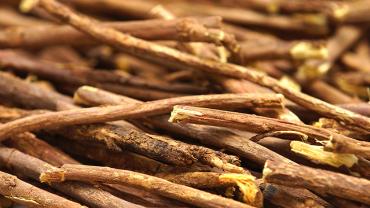
Licorice root has a long history of medicinal use, including the support of respiratory disorders, stomach ulcers, rheumatism, skin disorders, and more. Its traditional use has led to research into its potential for providing health benefits. Many of the possible health-promoting properties of licorice likely stem from its actions, which involve more than 400 compounds and phytochemicals, such as saponins, flavonoids, isoflavones, coumarins, and stilbenoids. Studies demonstrate that several of these support a healthy inflammatory response.*
There are several potential avenues for licorice root that may promote a healthy response to inflammation. One potential pathway is through the inhibition of the pro-inflammatory regulator nuclear transcription factor-kappa B (Nf-kB). In one mouse model of ulcerative colitis, treatment with a chalcone isolated from licorice root (licochalcone A, a compound from licorice widely used in traditional Chinese medicine) significantly decreased oxidative stress markers and pro-inflammatory cytokines through its activity on the NF-kB and nuclear factor erythroid 2-related factor 2 (Nrf2) pathways. The Nrf2 pathway is an important mechanism to protect against excessive oxidative stress, and NF-kB is a major regulator of the inflammatory response.
Other licorice compounds have also been found to modulate the NF-kB and Nrf2 pathways to promote anti-inflammatory and antioxidant effects. Excessive oxidative stress may contribute to inflammation, so compounds that support redox balance may also help mitigate inflammation. Nitric oxide is produced during inflammation and triggers additional inflammatory responses. Licorice may also help inhibit the production of nitric oxide.
In another animal study, treatment with glabridin (another compound in licorice) led to a reduction in tumor necrosis factor-alpha (TNF-alpha), which is a major inflammatory cytokine that triggers additional inflammatory responses. This also downregulated the gene expression for inducible nitric oxide synthase (iNOS), which led to the reduction of nitric oxide.
Another study found that additional compounds of licorice, including glycyrrhizin, isoliquiritigenin, isoliquiritin, and liquiritigenin also suppressed nitric oxide production. The minor compounds had even a larger impact on nitric oxide suppression than glycyrrhizin.
These animal and mechanistic studies have investigated the possible underlying activities that may contribute to the potential anti-inflammatory properties of licorice root. Several promising candidates for anti-inflammatory properties have been identified.
Clinical trials have demonstrated the potential for licorice root alone (including deglycyrrhizinated licorice root) or in combination with other herbs or compounds to potentially benefit Parkinson’s disease, non-alcoholic fatty liver disease, postoperative sore throat, gastroesophageal reflux disease (GERD), and asthma. In part, this may be due to the capacity of licorice to support a healthy inflammatory response.*
By Kendra Whitmire, MS, CNS